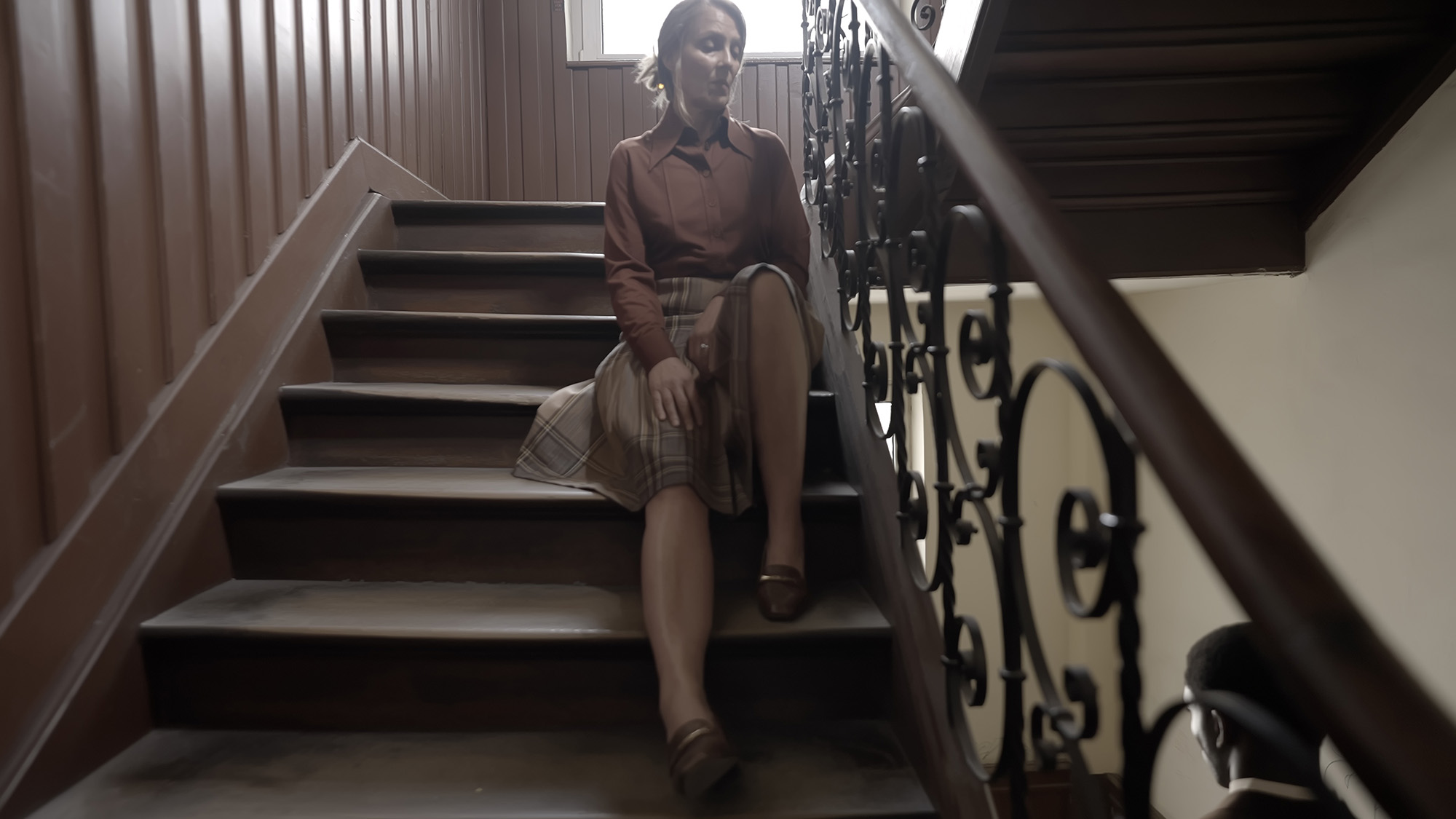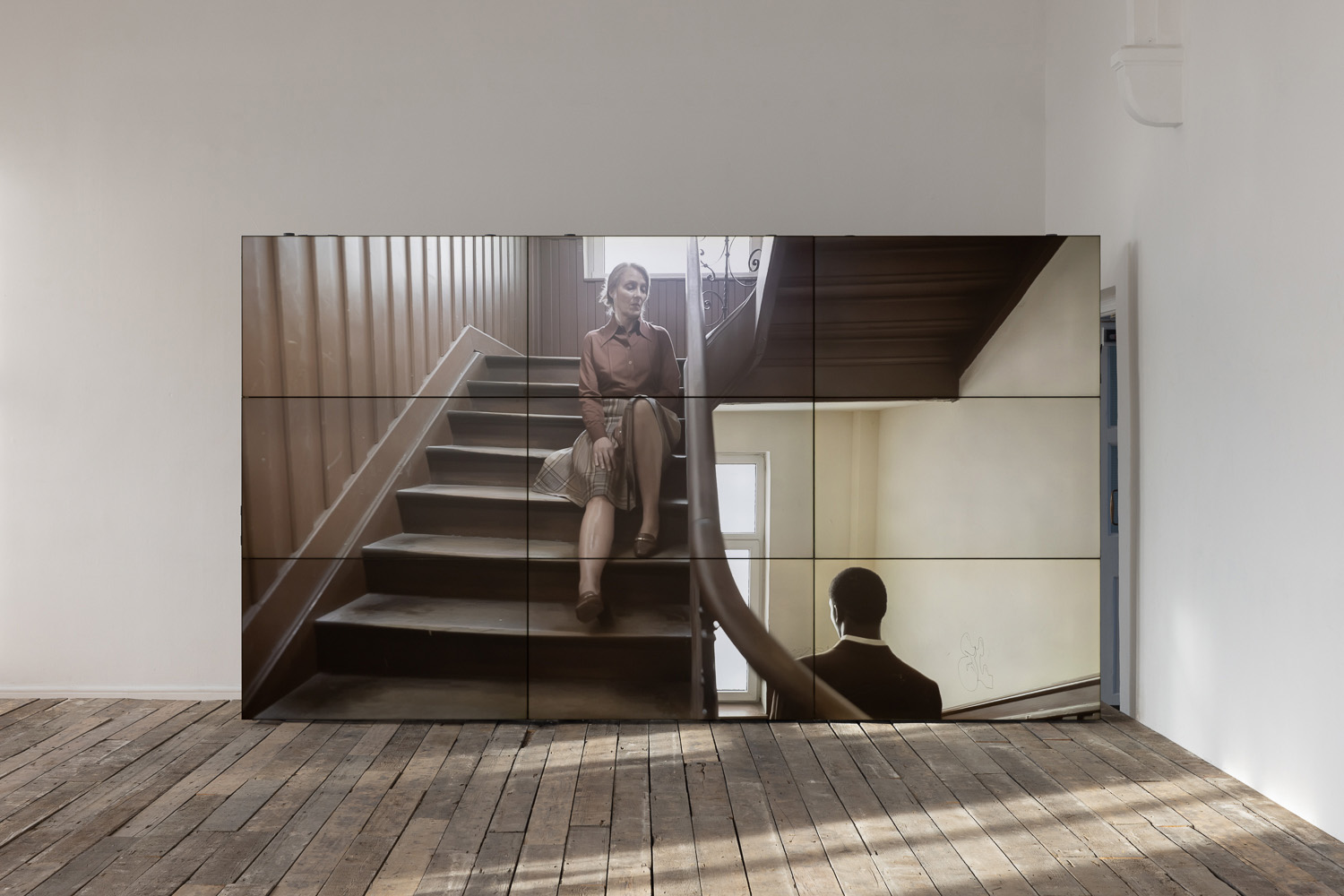The silence of the staircase: Atiéna
R. Kilfa’s Unhomely
In a new film by French artist Atiéna R. Kilfa, a shared staircase is stage & protagonist in a silent psychodrama, the film looping within an installation bearing uncanny similarity to the staircase setting. Nyima Murry stepped into Camden Art Centre for recessed.space to explore the underlying tension.
Sitting between the familiar and the surreal, The
Unhomely at Camden Art Centre uses an apartment building’s communal
staircase as a stage to explore the tension between two unnamed characters in a
highly charged film installation. Marking interdisciplinary French artist Atiéna R.
Kilfa’s first UK solo exhibition, the show centres around a large installation
of a raised platform of reclaimed floorboards, on which a film loops on a wall
of screens.
As people step on to the platform to watch the film, the boards creak loudly ensuing the obligatory grimace of apology for making such a noise in a gallery that is otherwise silent – bar a low rumble from the film’s soundtrack. What visitors don’t know is that this awkwardness has been curated by the artist – hidden microphones placed underneath the platform amplify every footstep, reverberating the impact around the room.
![]()
Panning across two immobilised figures, the film slowly inches up and down the stairwell to reveal an older white woman who sits above and watches, unnoticed, a young black man who appears to be walking down the stairs. Distant sounds of doors creaking – opening or closing shut? – can be occasionally heard, while the characters remained rooted to their spots. As the slow movement of the camera moves across their faces, there is something unnerving about their immobility – unblinking and without even a trace of breath, it's unclear if they are mannequin or human. This is only furthered by the lighting and staging of the scene, with clothes that sit stiffly against their bodies, and a glossiness to their skin that seems to be entirely poreless in the ultra-high definition quality of the camera.
Nothing happens. As soon the camera reaches the top of the staircase, we move back down it, caught in the tension between these two individuals. And yet, without saying anything, the scene is filled with drama. Loosely referencing Rainer Werner Fassabinder’s 1974 melodrama Ali: Fear Eats the Soul in which an elderly Polish cleaning lady and Moroccan migrant worker fall in and out of love, in Kilfa’s work it is unclear if the protagonists are even human, let alone lovers or strangers.
![]()
The work throughout feels familiar to anyone who has lived in close quarters with strangers. We can recognise the stairway of an apartment block and immediately understand the organisation of the building. We know that there will be homes behind the doors on each floor, and therefore the way we are expected to behave in this communal stairwell. However, the small architectural scale model of the stairs we see in the film that sits in the corner of the installation disrupts this. In the maquette, there are no landings leading to rooms, only the endless staircase, and with it the question of how to behave.
Communal space has been designed out of apartment buildings like this example, to be limited to as little as possible. Domestic activities like washing or cleaning are now contained in each home, with the only space for interaction between residents now the stairway. Not conducive for comfortable conversation, the feelings of echoing acoustics and lack of privacy have been pulled to the extreme in Kilfa’s stairway, where the sanctuary of the private space of the home has been eliminated.
![]()
The architecture in the film is the third protagonist. For every moment of action from the figures, the use of familiar architectural features creates an equal sense of inaction, fluctuating between subject and object, animate and inanimate. Gaps in the ornate metal banister provide a sightline for the woman to watch the man below unnoticed, becoming an animated agent when the camera pans, then returning to inanimate backdrop when it is no longer key participant in the drama.
By showcasing the film within the installation, the architecture of the gallery space mirrors the watched space of the film. The platform is used as a mechanism to draw visitors into a sense of self-consciousness, with every movement recorded and projected back. There is no space for a distant observer.
![]()
As people step on to the platform to watch the film, the boards creak loudly ensuing the obligatory grimace of apology for making such a noise in a gallery that is otherwise silent – bar a low rumble from the film’s soundtrack. What visitors don’t know is that this awkwardness has been curated by the artist – hidden microphones placed underneath the platform amplify every footstep, reverberating the impact around the room.

Panning across two immobilised figures, the film slowly inches up and down the stairwell to reveal an older white woman who sits above and watches, unnoticed, a young black man who appears to be walking down the stairs. Distant sounds of doors creaking – opening or closing shut? – can be occasionally heard, while the characters remained rooted to their spots. As the slow movement of the camera moves across their faces, there is something unnerving about their immobility – unblinking and without even a trace of breath, it's unclear if they are mannequin or human. This is only furthered by the lighting and staging of the scene, with clothes that sit stiffly against their bodies, and a glossiness to their skin that seems to be entirely poreless in the ultra-high definition quality of the camera.
Nothing happens. As soon the camera reaches the top of the staircase, we move back down it, caught in the tension between these two individuals. And yet, without saying anything, the scene is filled with drama. Loosely referencing Rainer Werner Fassabinder’s 1974 melodrama Ali: Fear Eats the Soul in which an elderly Polish cleaning lady and Moroccan migrant worker fall in and out of love, in Kilfa’s work it is unclear if the protagonists are even human, let alone lovers or strangers.

The work throughout feels familiar to anyone who has lived in close quarters with strangers. We can recognise the stairway of an apartment block and immediately understand the organisation of the building. We know that there will be homes behind the doors on each floor, and therefore the way we are expected to behave in this communal stairwell. However, the small architectural scale model of the stairs we see in the film that sits in the corner of the installation disrupts this. In the maquette, there are no landings leading to rooms, only the endless staircase, and with it the question of how to behave.
Communal space has been designed out of apartment buildings like this example, to be limited to as little as possible. Domestic activities like washing or cleaning are now contained in each home, with the only space for interaction between residents now the stairway. Not conducive for comfortable conversation, the feelings of echoing acoustics and lack of privacy have been pulled to the extreme in Kilfa’s stairway, where the sanctuary of the private space of the home has been eliminated.

The architecture in the film is the third protagonist. For every moment of action from the figures, the use of familiar architectural features creates an equal sense of inaction, fluctuating between subject and object, animate and inanimate. Gaps in the ornate metal banister provide a sightline for the woman to watch the man below unnoticed, becoming an animated agent when the camera pans, then returning to inanimate backdrop when it is no longer key participant in the drama.
By showcasing the film within the installation, the architecture of the gallery space mirrors the watched space of the film. The platform is used as a mechanism to draw visitors into a sense of self-consciousness, with every movement recorded and projected back. There is no space for a distant observer.

Atiéna R. Kilfa (b.1990, France), currently lives and works in Frankfurt am Main where she recently graduated from Staedelschule. In her practice, Kilfa uses photography, sculpture, video, and installations to explore how personal and cultural memories tend to conflict and overlap. The Unhomely at Camden Art Centre marks the first institutional solo exhibition by the artist in the UK.
Nyima Murry is a British-Tibetan architectural designer, curator, and filmmaker. She is currently undertaking a Masters in Landscape Architecture at the Bartlett, UCL.
www.instagram.com/nyimamurry
www.instagram.com/nyimamurry
visit
The Unhomely, by Atiéna R. Kilfa, is exhibited at Camden Art Centre until 28 May 2023, more information available at:
www.camdenartcentre.org/whats-on/the-unhomely
images
still images The Landlords, 2022.
Video still, courtesy the artist.
installation images Installation views of The Unhomely, at Camden Art Centre. Photography © Rob Harris.
publication date
20 February 2022
tags
Apartment, Camden Art Centre, Creak, Rainer Werner Fassbinder, Film,
Floorboard, Gaze, Installation, Atiéna R Kilfa, Nyima Murry, Model, Stair,
Staircase, Watching
www.camdenartcentre.org/whats-on/the-unhomely


